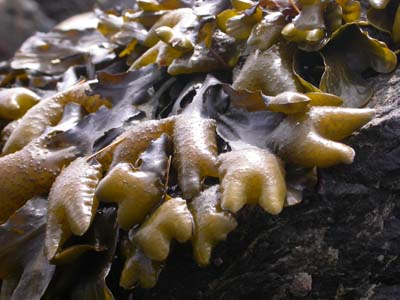
Rockweed
Ecology
|
|
F. distichus plays an important ecological role in the temperate rocky intertidal. Unlike the majority of marine algae that grow better when submerged, Fucus demonstrates consistent growth patterns when exposed (3). In the high rocky intertidal, physical stressors and herbivory are the main factors limiting algal distribution (3). Fucus, however, forms dense homogenous carpets in this high-stress environment. Various physiological adaptations have allowed this genus to settle and thrive here(1). Initially, Fucus zygotes are highly resilient to freezing temperatures, desiccation and heat stress; all of which increase settlement in the high rocky intertidal (1). Furthermore, germination can occur in light or dark environments, which allows for greater temporal flexibility (1). In terms of species interactions, Fucus colonization of the high intertidal sequesters moisture and forms important refuge habitat for many intertidal invertebrates including littorina spp., various isopods, etc (personal observation). This refuge habitat, however, is home to numerous algal grazers. F. distichus allocates a large portion of available resources toward the production of phlorotannins: polyphenolic compounds that act as repellants against these abundant grazers (3). Intermittent sloughing-off of epidermal cell layers and copious external mucus production function to ward off epiphytic growth (2).
|
-
Vijayaraghavan, M.R. et al. Brown Algae: Structure, ultrastructure and reproduction. APH Publishing Corp 1998.
-
Van Den Hoek, C. et al. Algae: An Introduction to Phycology. Cambridge University Press 1995.
- Dethier, M. et al. Seasonal stresses shift optimal intertidal algal habitats. Mar Biol (2009) 156: 555-567.
